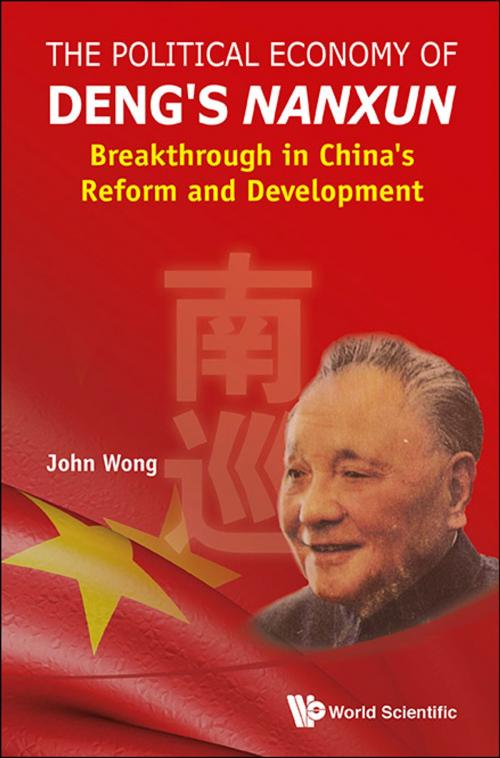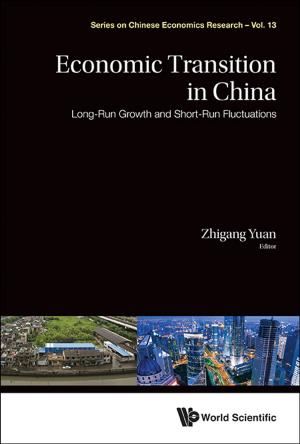The Political Economy of Deng's Nanxun
Breakthrough in China's Reform and Development
Business & Finance, Economics, Economic Development, Nonfiction, Social & Cultural Studies, Political Science, Politics, Economic Conditions| Author: | John Wong | ISBN: | 9789814578400 |
| Publisher: | World Scientific Publishing Company | Publication: | February 24, 2014 |
| Imprint: | WSPC | Language: | English |
| Author: | John Wong |
| ISBN: | 9789814578400 |
| Publisher: | World Scientific Publishing Company |
| Publication: | February 24, 2014 |
| Imprint: | WSPC |
| Language: | English |
This volume is about the political economy of Deng Xiaoping's Nanxun (tour of South China), which was the most critical phase in China's reform and development since 1978. The first round of Deng's reform resulted in high growth through the 1980s. However, it created a messy half-reformed economy with many problems, including the Tiananmen incident. The immediate aftermath of the Tiananmen was collapse of economic growth and reform deadlock. To break out from this low-level “reform-growth trap”, Deng decided to launch the Nanxun, not just to reignite the reform but also to complete China's march towards a market economy. Looking back, the Nanxun led to the most crucial reform breakthrough, which, in turn, sparked off a dynamic reform-growth-nexus for China's eventual economic take-off.
The chapters in this volume were originally “policy reports” on China, meant for the Singapore government. These reports were written based on the information available at that time, and reflected the prevailing political mood.
Each chapter is accompanied by a detailed introduction that is aimed at providing a broad background for readers to better understand the Nanxun period. The introduction also serves as a post-evaluation of the events based on new information, and shows how those events have evolved over the years. In combination, these chapters should piece together a reasonably realistic picture of the basic politics and economics of the crucial Nanxun period.
Contents:
-
Introduction
-
Background Chapters:
- China's Per-Capita GNP at the Beginning of Economic Reform
- China's Entrepreneurial Approach to Economic Reform
-
The Politics and Economics of Deng's Nanxun:**
- The 7th Party Plenum 1990 and the Continuing Post-Tiananmen Political Stalemate Over Reform
- What is in the Surname, She or Zi: The Post-Tiananmen Ideological Discord
- Economic Upsurge in 1992: An Immediate Nanxun Effect
- What has China Accomplished in Economic Reform in 1994?
- Soft-Landing of the Economy in 1995: The Nanxun's Climax
- China's Ninth Five-Year Plan, 1996–2000
-
Agricultural and Rural Development:
- The Quiet Industrial Revolution in the Chinese Countryside: Township and Village Enterprises (TVEs)
- Why Deng was So Concerned About Agriculture
-
Foreign Trade and Investment:
- Progress in Foreign Trade Reform
- China and the GATT
- China and the World Trade Organization
- Southeast Asian Ethnic Chinese Investing in China
Readership: Academics, professionals, policy makers, undergraduate and graduate students interested in China's economic development, China's reform and the open-door policy.
This volume is about the political economy of Deng Xiaoping's Nanxun (tour of South China), which was the most critical phase in China's reform and development since 1978. The first round of Deng's reform resulted in high growth through the 1980s. However, it created a messy half-reformed economy with many problems, including the Tiananmen incident. The immediate aftermath of the Tiananmen was collapse of economic growth and reform deadlock. To break out from this low-level “reform-growth trap”, Deng decided to launch the Nanxun, not just to reignite the reform but also to complete China's march towards a market economy. Looking back, the Nanxun led to the most crucial reform breakthrough, which, in turn, sparked off a dynamic reform-growth-nexus for China's eventual economic take-off.
The chapters in this volume were originally “policy reports” on China, meant for the Singapore government. These reports were written based on the information available at that time, and reflected the prevailing political mood.
Each chapter is accompanied by a detailed introduction that is aimed at providing a broad background for readers to better understand the Nanxun period. The introduction also serves as a post-evaluation of the events based on new information, and shows how those events have evolved over the years. In combination, these chapters should piece together a reasonably realistic picture of the basic politics and economics of the crucial Nanxun period.
Contents:
-
Introduction
-
Background Chapters:
- China's Per-Capita GNP at the Beginning of Economic Reform
- China's Entrepreneurial Approach to Economic Reform
-
The Politics and Economics of Deng's Nanxun:**
- The 7th Party Plenum 1990 and the Continuing Post-Tiananmen Political Stalemate Over Reform
- What is in the Surname, She or Zi: The Post-Tiananmen Ideological Discord
- Economic Upsurge in 1992: An Immediate Nanxun Effect
- What has China Accomplished in Economic Reform in 1994?
- Soft-Landing of the Economy in 1995: The Nanxun's Climax
- China's Ninth Five-Year Plan, 1996–2000
-
Agricultural and Rural Development:
- The Quiet Industrial Revolution in the Chinese Countryside: Township and Village Enterprises (TVEs)
- Why Deng was So Concerned About Agriculture
-
Foreign Trade and Investment:
- Progress in Foreign Trade Reform
- China and the GATT
- China and the World Trade Organization
- Southeast Asian Ethnic Chinese Investing in China
Readership: Academics, professionals, policy makers, undergraduate and graduate students interested in China's economic development, China's reform and the open-door policy.















